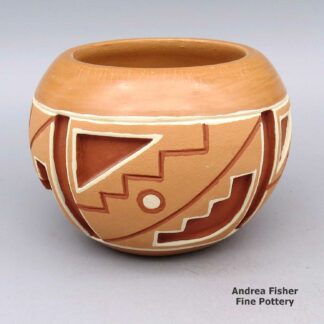de Herrera, Rosita
Rosita de Herrera was born into Ohkay Owingeh in 1940. Her mother was Tomasita Reyes Montoya. Tomasita was one of the seven Ohkay Owingeh women who redefined Ohkay Owingeh pottery in the 1930s.
Some ancient Tewa pottery had been found on Ohkay Owingeh land and it was dated by archaeologists to have been made just prior to the arrival of the Spanish in New Mexico. They based their definition on that pottery and named it Potsuwi’i, after the ancient pueblo where it was found.
They settled on decorating redware pots with a matte design band that featured the old incised designs (that are similar to a lot of rock art found across the Southwest). Rosita and her sister, Dominguita Sisneros, grew up learning to make that style of pottery from their mother. Rosita’s son, Norman de Herrera, grew up learning how to make pottery the same way, from Rosita.
Rosita was active in the marketplace by the early 1970s. She mostly made incised polychrome buff-on-red bowls in the Potsuwi’i style and incised blackware bowls in a more recent (colonial) Ohkay Owingeh style.
Showing the single result
Showing the single result
